标签 墨西哥 下的文章
大群的芒基蝠鲼跃出水面,墨西哥加利福尼亚湾 Large school of Munk's pygmy devil rays from the air, Gulf of California, Mexico (© Mark Carwardine/Minden Pictures)

大群的芒基蝠鲼跃出水面,墨西哥加利福尼亚湾 Large school of Munk's pygmy devil rays from the air, Gulf of California, Mexico (© Mark Carwardine/Minden Pictures)
Rays on parade
The feeding frenzy is on! Each spring and fall, the waters off Mexico's Baja California peninsula become the perfect place to spot Munk's devil rays in massive schools like this one. Unlike stingrays (and perhaps the devil), devil rays lack fearsome pointy tails. In fact, these giants—whose wingspans can reach about 9 feet—are pretty gentle all around, feeding mainly on plankton. And for them, mealtime is party time: During huge devil ray gatherings like this, rays are seen continually bursting out of the water and landing with loud bellyflops.
射线在游行
喂食狂潮开始了!每年春天和秋天,墨西哥下加利福尼亚半岛附近的水域都会成为在像这样的大型学校里发现芒克魔鬼鱼的最佳地点。不像黄貂鱼(也许还有魔鬼),魔鬼鱼没有可怕的尖尾巴。事实上,这些翼展能达到9英尺左右的巨型生物四周都很温和,主要以浮游生物为食。对他们来说,进餐时间是聚会时间:在这样的大型魔鬼鱼聚会上,可以看到鱼不断地从水里迸发出来,并带着响亮的肚脐落地。
一个气球在特奥蒂瓦坎日出时飞越太阳金字塔,墨西哥气球在特奥蒂瓦坎日出时飞越太阳金字塔 A balloon flies over the Pyramid of the Sun at sunrise in Teotihuacan, MexicoA balloon flies over the Pyramid of the Sun at sunrise in Teotihuacan, Mexico (©
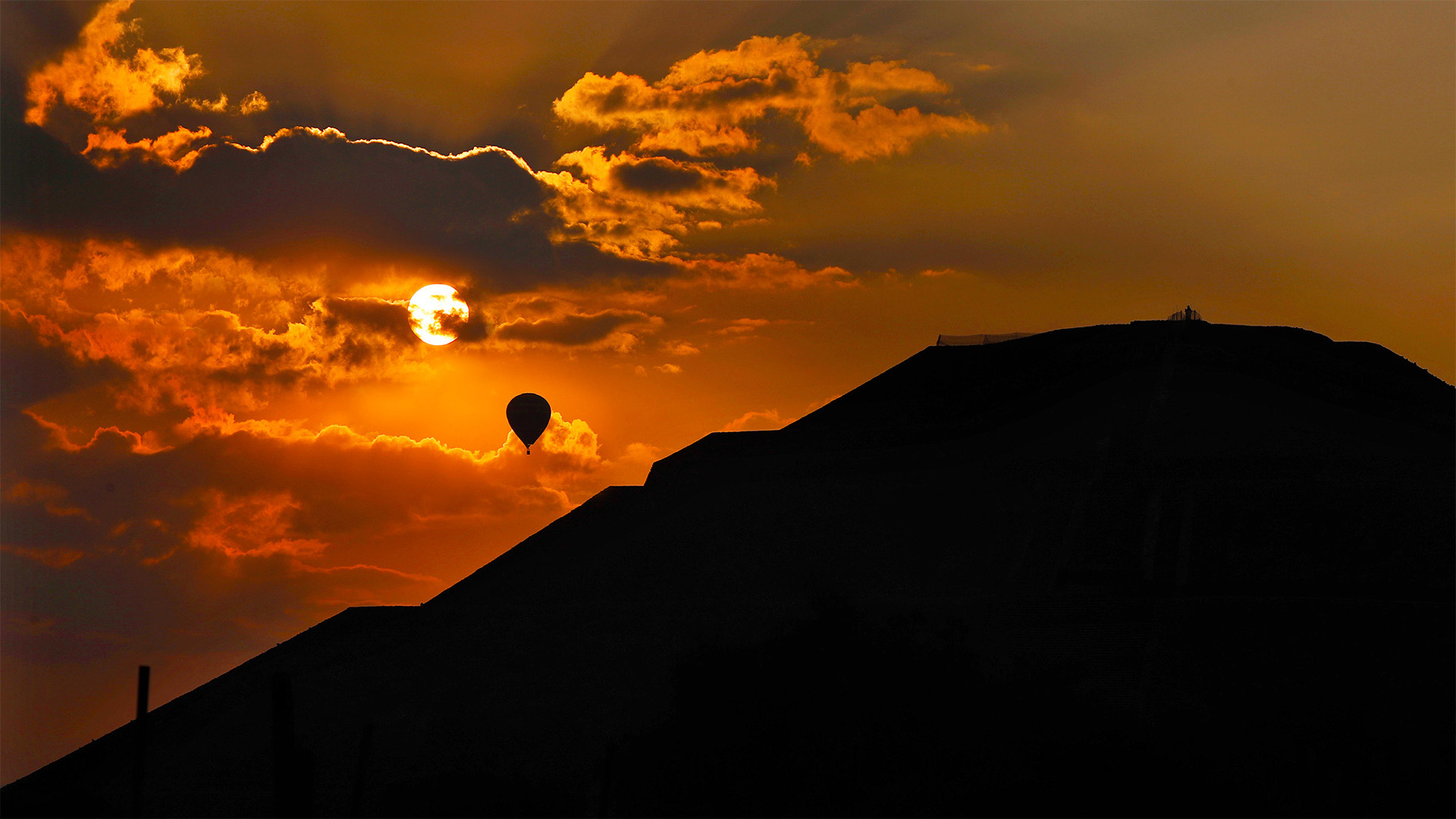
一个气球在特奥蒂瓦坎日出时飞越太阳金字塔,墨西哥气球在特奥蒂瓦坎日出时飞越太阳金字塔 A balloon flies over the Pyramid of the Sun at sunrise in Teotihuacan, Mexico (© Marco Ugarte/AP Photo)
Ringing in the New Year at Teotihuacan
If the Aztecs had hot air balloons, they may well have greeted the new year like this—floating above the massive Sun Pyramid at sunrise today, the first day of the year according to the Aztec calendar. Also known as Yancuic Xihuitl, the Aztec New Year is still celebrated by some Indigenous Nahua communities here in central Mexico with songs, dances, and the flames of 'ocote' (pitch-pine) candles. Dancers wear colorful traditional costumes topped by quetzal feather headdresses, and celebrants greet the New Year by making loud noises with seashells, just as Aztecs did centuries ago. It's one of the many expressions of pre-Columbian tradition that managed to survive the Spanish conquest and modern erosion of Indigenous customs.
The Sun Pyramid is the largest structure in the ancient city that Aztecs called Teotihuacan (which means, roughly, 'birthplace of the gods'). The 8-square-mile site also contains other important pyramids, plazas, temples, palaces, and a complex network of underground tunnels. As grand a city as it once was, when the Aztecs arrived here in the 1400s, Teotihuacan had been abandoned for centuries. Its precise origins are a mystery, but it was first built by an unknown civilization sometime around 400 BCE. By 400 CE, Teotihuacan had become a center of industry and trade, the largest and most powerful city in the Americas and probably the sixth largest in the world. But by around 550 CE, its major monuments were sacked and deliberately burned, the magnificent pyramids and temples deserted—at least until the Aztecs arrived.
在特奥提华肯新年钟声响起
如果阿兹特克人有热气球的话,他们很可能在今天日出的时候,也就是阿兹特克日历上一年的第一天,像这样漂浮在巨大的太阳金字塔上迎接新年。阿兹特克新年也被称为Yancuic Xihuitl,墨西哥中部的一些土著Nahua社区仍然用歌声、舞蹈和“ocote”(沥青松)蜡烛的火焰来庆祝。舞者们穿着色彩鲜艳的传统服装,头上戴着羽绒头饰,庆祝者用贝壳发出响亮的声音迎接新年,就像几个世纪前阿兹特克人所做的那样。这是许多前哥伦布传统的表达方式之一,这些传统在西班牙征服和现代土著习俗的侵蚀下得以幸存。
太阳金字塔是古城中最大的建筑,阿兹特克人称之为特奥提瓦坎(大致意思是“神的诞生地”)。这个8平方英里的遗址还包括其他重要的金字塔、广场、寺庙、宫殿和复杂的地下隧道网络。当阿兹特克人在14世纪来到这里时,特奥提瓦坎曾经是一座宏伟的城市,但它已经被遗弃了几个世纪。它的确切起源是个谜,但它最初是由公元前400年左右的一个未知文明建造的。到公元400年,特奥蒂瓦坎已经成为一个工业和贸易中心,美洲最大和最强大的城市,可能是世界第六大城市。但到公元前550年左右,它的主要纪念碑被洗劫一空,并被蓄意烧毁,宏伟的金字塔和寺庙被遗弃,至少直到阿兹特克人到来。
被丛林包围着的玛雅古城卡拉克穆尔遗址,墨西哥坎佩切 Ruins of the ancient Mayan city of Calakmul surrounded by the jungle, Campeche, Mexico (© Alfredo Matus/Shutterstock)
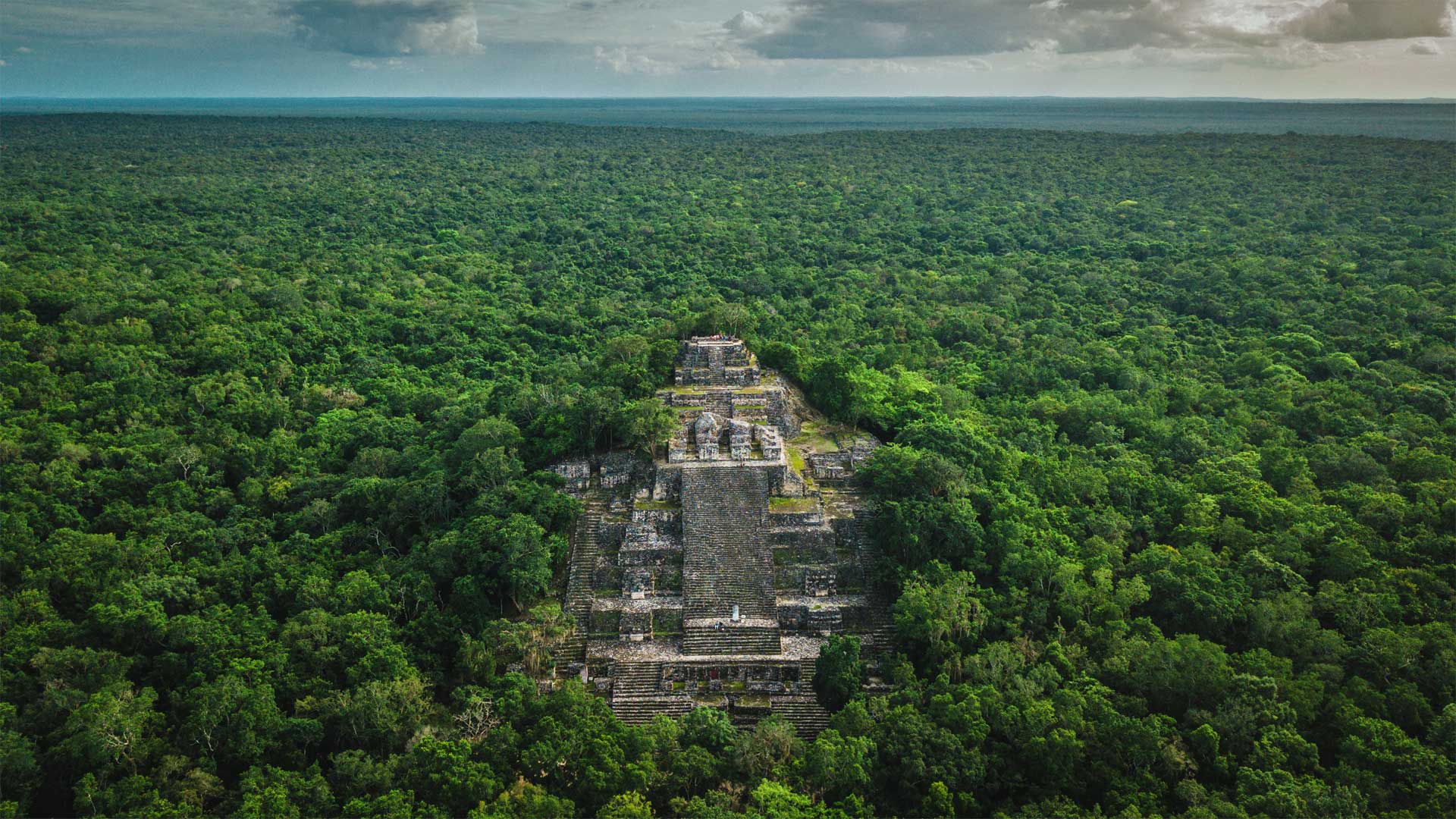
被丛林包围着的玛雅古城卡拉克穆尔遗址,墨西哥坎佩切 Ruins of the ancient Mayan city of Calakmul surrounded by the jungle, Campeche, Mexico (© Alfredo Matus/Shutterstock)
The ruins of a Mayan superpower
Deep in the jungle of southern Mexico lay the ruins of a city that thrived for centuries before it was abandoned more than 1,000 years ago. Calakmul was once one of the two dueling superpowers—along with Tikal—of the Classical Mayan civilization. At its height, around 1,200 years ago, the city of Calakmul had a population of about 50,000 people, but the kingdom as a whole numbered more than 1.5 million. Archaeologists have uncovered 6,750 structures here—the largest is this pyramid temple, called, simply, 'Structure 2.' It's one of the tallest and most massive remaining structures from that highly advanced culture. The ruins of the city proper cover nearly eight square miles in the jungle and the kingdom once ruled over settlements as far as 90 miles away.
All the more amazing, then, that it was apparently lost to history until an American botanist named Cyrus L. Lundell discovered it when flying over the jungle on a survey of the area in December 1931. A few expeditions were sent to explore it over the next few years, but it went largely unstudied until the 1980s. Calakmul is now recognized as one of the most important archeological sites in southern Mexico.
玛雅超级大国的废墟
在墨西哥南部的丛林深处,有一座城市在1000多年前被遗弃之前,已经繁荣了几个世纪。卡拉克穆尔曾是古典玛雅文明的两个决斗超级大国之一,与提卡尔一起。大约1200年前的鼎盛时期,卡拉克穆尔市的人口约为5万人,但王国整体人口超过150万。考古学家在这里发现了6750座建筑——最大的是这座金字塔神庙,简单地说,叫做"结构2"。它是高度先进文化中最高和最具大规模剩余结构之一。这座城市的废墟覆盖了丛林中近8平方英里的面积,王国曾经统治着90英里外的定居点。
更令人惊奇的是,它显然被历史所遗忘,直到1931年12月一位名叫赛勒斯·伦德尔的美国植物学家在一次对该地区的勘测中飞越丛林时发现了它。在接下来的几年里,一些探险队被派去探索它,但直到20世纪80年代它才被广泛研究。卡拉克穆尔现在被认为是墨西哥南部最重要的考古遗址之一。卡拉克穆尔现在被公认为墨西哥南部最重要的考古遗址之一。
瓜纳华托,墨西哥 Guanajuato, Mexico (© AI NISHINO/Alamy)
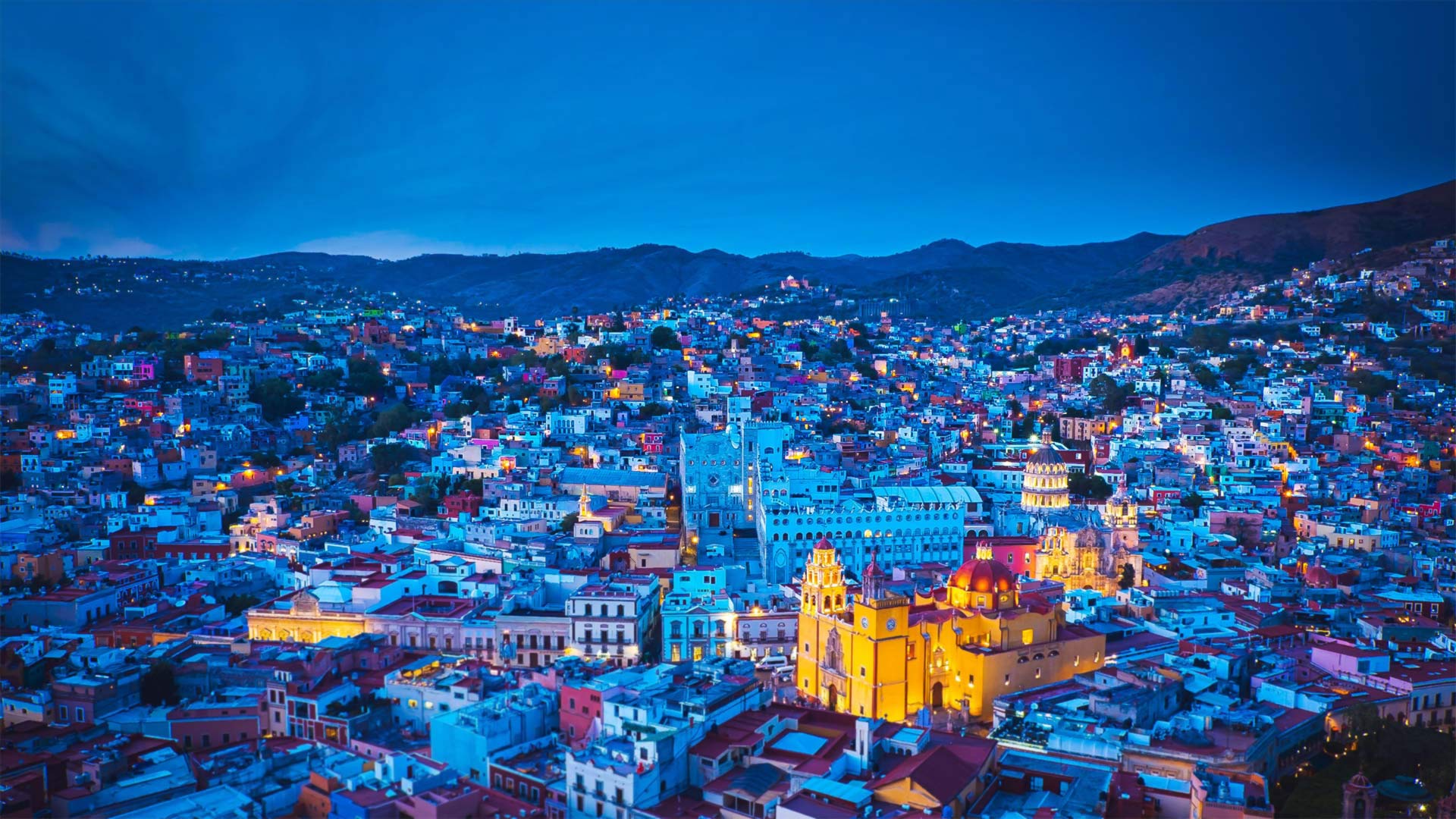
瓜纳华托,墨西哥 Guanajuato, Mexico (© AI NISHINO/Alamy)
It's Independence Day in Mexico
In honor of today's Independence Day holiday in Mexico, our homepage comes from the state of Guanajuato—where the country's battle for independence first began. The conflict started with the 'Cry of Delores,' an event on September 16, 1810, when priest Miguel Hidalgo y Costilla rang the church bell in the nearby town of Delores and called for a revolt to free Mexico from Spanish control. His call to arms triggered the formation of an insurgency that marched onward to San Miguel and then to the city of Guanajuato (featured on our homepage). The ensuing conflict spanned more than a decade, culminating with Mexico finally breaking free from Spanish rule in 1821.
Since then, the 'Cry of Delores' has come to symbolize the very idea of Mexican independence. Each year on the eve of Independence Day, the president of Mexico re-enacts the call to arms from the balcony of the National Palace in Mexico City, while ringing the same bell that Hidalgo used that day on September 16, 1810.
圣路易斯波托西州的Tamul瀑布,墨西哥 Tamul waterfall in the state of San Luis Potosí, Mexico (© Robert Harding World Imagery/Offset by Shutterstock)
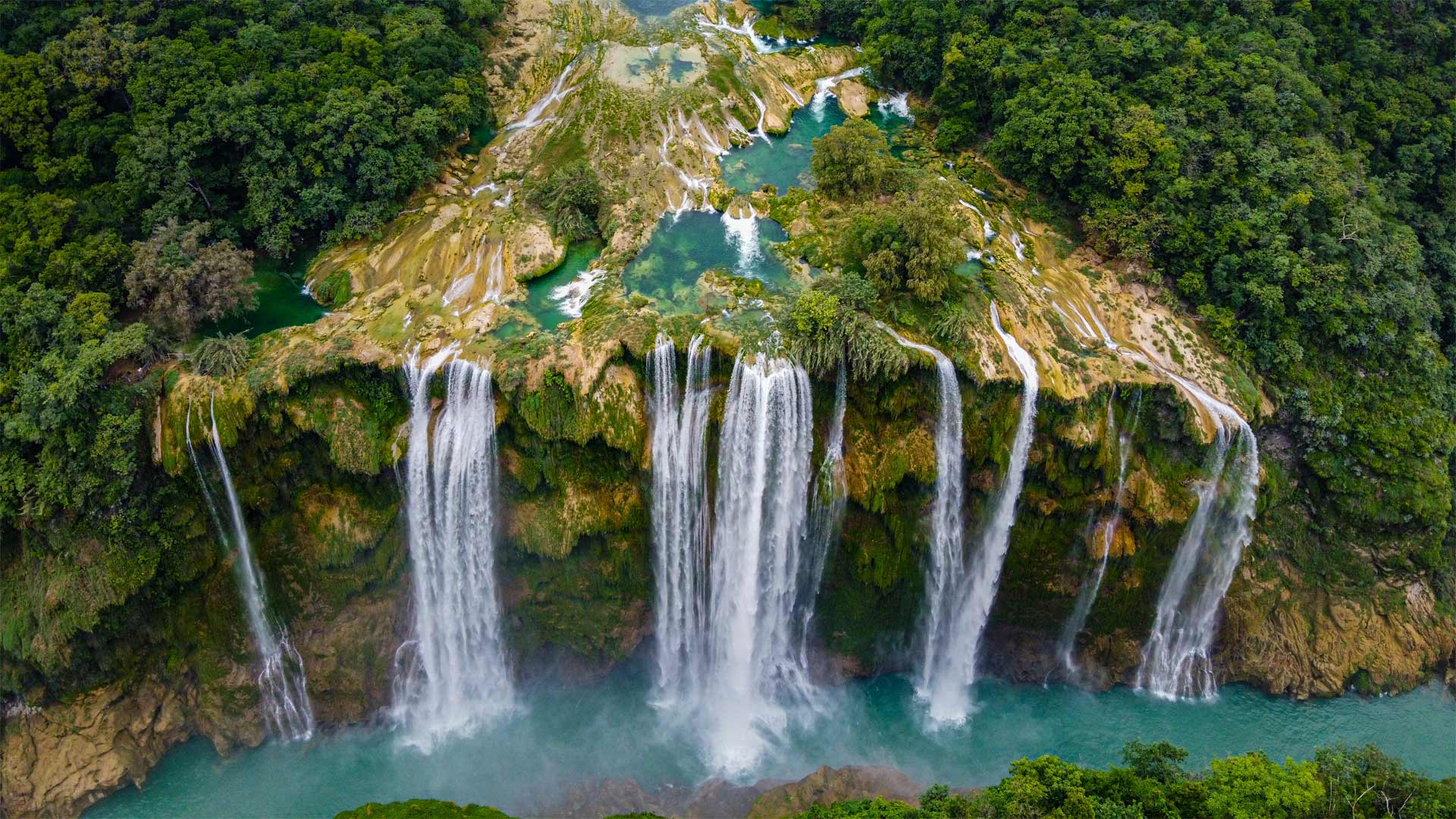
圣路易斯波托西州的Tamul瀑布,墨西哥 Tamul waterfall in the state of San Luis Potosí, Mexico (© Robert Harding World Imagery/Offset by Shutterstock)
A stunning sight in Mexico's wilderness
Here in central Mexico, the Gallinas River spills into the Tampaón River gorge to create Tamul waterfall, renowned as a jewel of the country's wilderness. Both rivers offer great swimming near the falls, and boaters can float by on the Tampaón for close-up views. Both activities are best attempted between July and October, though: During wetter months, the falls converge into a thundering cataract as the Gallinas rises to form torrential rapids.
In the ancient Huastec language, Tamul means 'place of pitchers,' comparing the cenotes—or underwater sinkholes—that dot the Gallinas riverbed to giant vessels being poured out by the gods. This corner of the state of San Luis Potosí was once a domain of the Huastecs, who split from the Maya three to four millennia ago to settle the lands from here east to the Gulf of Mexico. By the early 16th century, the society crumbled as other Mesoamerican cultures gained influence and the Spanish began colonizing Mexico. But many of their stone temples and earthen pyramids in the region still remain, as do tens of thousands of native Huastec speakers.
Gondolas called trajineras in the canals of Xochimilco, Mexico City, Mexico (© Orbon Alija/Getty Images)

Gondolas called trajineras in the canals of Xochimilco, Mexico City, Mexico (© Orbon Alija/Getty Images)
Cinco de Mayo in Xochimilco
This aerial view comes from Xochimilco, a borough of Mexico City that's famous for its canals, leftover from a lake and canal system that once connected settlements in the Valley of Mexico. The canals are best explored from these colorful gondola-like boats known as a trajineras, floating past artificial islands that were once used for agriculture.
We think the Xochimilco canals would be a fine place to celebrate Cinco de Mayo today. While Americans often confuse the holiday with Mexico's Independence Day, it's actually the anniversary of Mexico's 1862 victory over France at the Battle of Puebla. The victory was especially significant because the Mexicans overcame France despite having a much smaller, less equipped army. When France later took Mexico City, the Battle of Puebla remained a source of Mexican pride and hope during the occupation.
Dos Ojos自然公园里El Pit Cenote的潜水员,墨西哥金塔纳罗奥 Divers at El Pit Cenote, located in Dos Ojos Natural Park, Quintana Roo, Mexico (© Christia Vizl/Tandem Stills + Motion)

Dos Ojos自然公园里El Pit Cenote的潜水员,墨西哥金塔纳罗奥 Divers at El Pit Cenote, located in Dos Ojos Natural Park, Quintana Roo, Mexico (© Christia Vizl/Tandem Stills + Motion)
The desert blooms
It's getting to be wildflower season in the Sonoran Desert of Arizona. That means it won't be long before we see blooms from the big daddy of the cactus world–the saguaro. Our homepage pic shows just a glimpse of this amazing succulent. The saguaro is the largest cactus in the United States, capable of growing upwards of 50 feet tall and weighing several tons (that's when it's fully hydrated). It can live more than 100 years and will grow arms as it ages, creating that classic cactus profile that's associated with the desert and Old West. As for its flowers, they're short-lived, typically blooming at dusk and remaining open till midmorning the next day. The flowers form only at the top of the plant and the tips of branches. The blooms are striking enough to be honored as Arizona's state flower. Later they'll produce a red, edible fruit that will ripen by July.
秋分时日的卡斯蒂略金字塔,墨西哥奇琴伊察 Equinox at the Temple of Kukulcan in Chichen Itza, Mexico (© Somatuscani/Getty Images Plus)
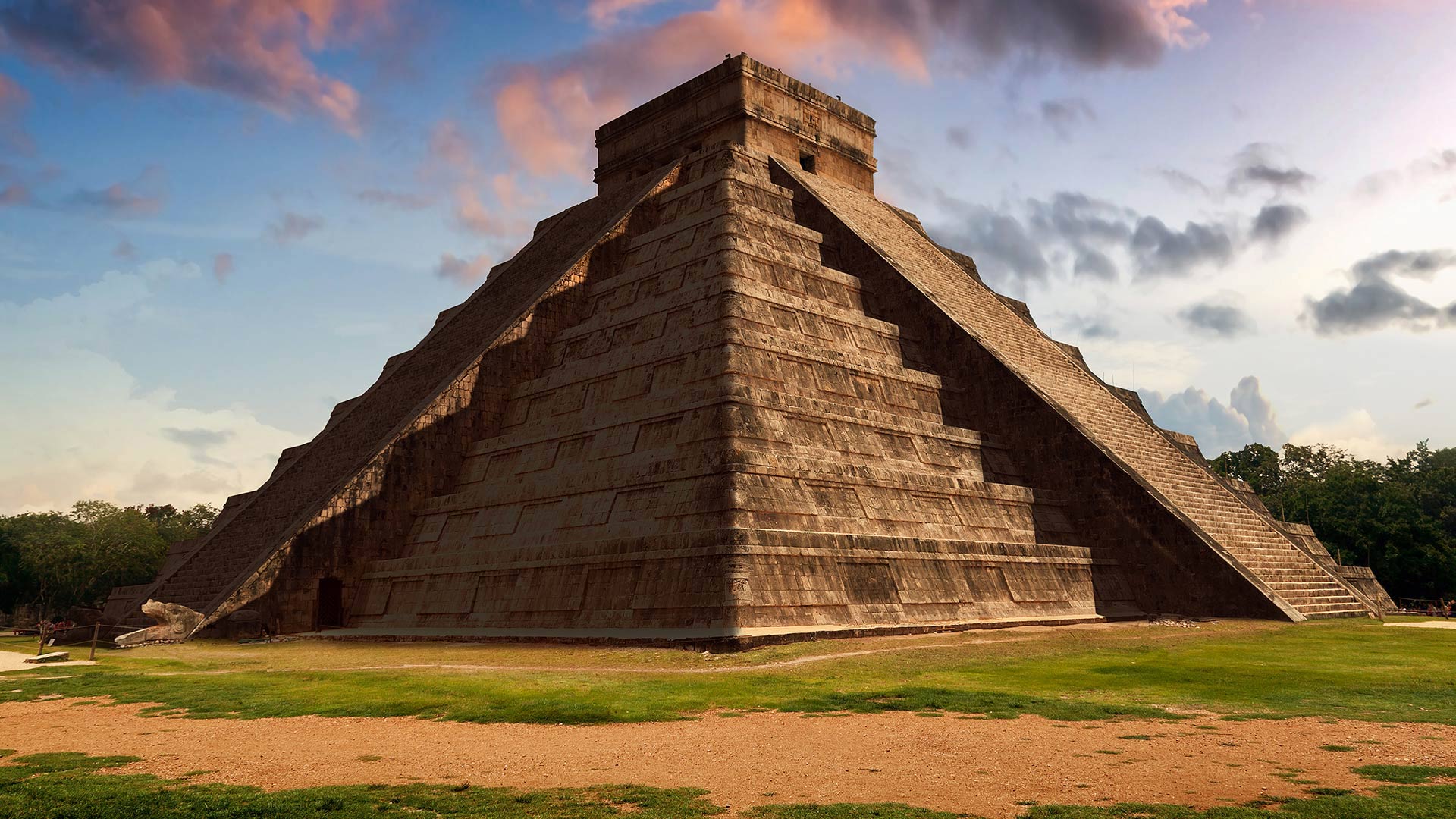
秋分时日的卡斯蒂略金字塔,墨西哥奇琴伊察 Equinox at the Temple of Kukulcan in Chichen Itza, Mexico (© Somatuscani/Getty Images Plus)
Stepping into autumn
Look closely and you'll see a snake slithering down the steps of the Temple of Kukulcan (aka El Castillo or The Castle), in Chichen Itza, Mexico. Not a real snake, it's an image created by natural light and shadows only during the spring and fall equinoxes. The equinox (which means equal night in Latin) is either of the two times each year—like today, the first day of fall—when the Earth's orbit and position cause the Sun to pass directly over the equator, creating equal amounts of daylight and darkness. According to Mayan legend, on both equinoxes this pyramid is visited by Kukulcan, the feathered serpent god. Thousands of spectators gather to watch and celebrate as seven triangles of light slide down the pyramid, illustrating Kukulcan's descent.
圣米格尔·德阿连德,墨西哥 San Miguel de Allende, Mexico (© ferrantraite/Getty Images)
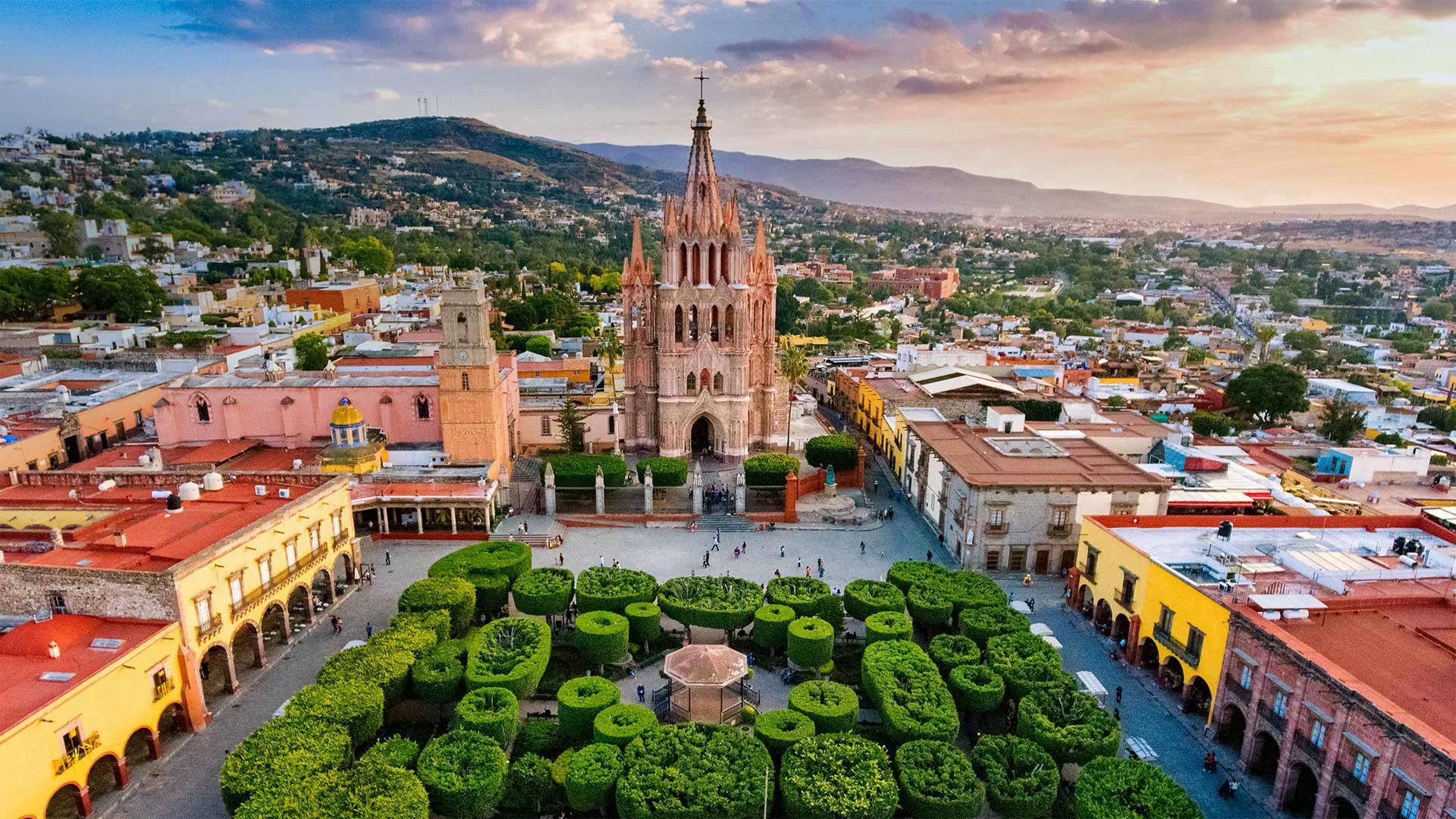
圣米格尔·德阿连德,墨西哥 San Miguel de Allende, Mexico (© ferrantraite/Getty Images)
